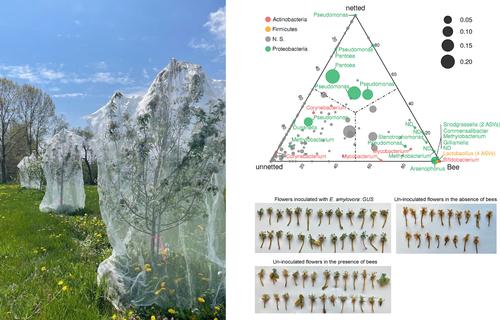当前位置:
X-MOL 学术
›
Environ. Microbiol.
›
论文详情
Our official English website, www.x-mol.net, welcomes your
feedback! (Note: you will need to create a separate account there.)
The role of foraging pollinators in assembling the flower microbiota and transmitting the fire blight pathogen Erwinia amylovora
Environmental Microbiology ( IF 4.3 ) Pub Date : 2024-10-10 , DOI: 10.1111/1462-2920.16702 Salma Mukhtar, M. Amine Hassani, Tracy Zarrillo, Zhouqi Cui, George W. Sundin, Quan Zeng
Environmental Microbiology ( IF 4.3 ) Pub Date : 2024-10-10 , DOI: 10.1111/1462-2920.16702 Salma Mukhtar, M. Amine Hassani, Tracy Zarrillo, Zhouqi Cui, George W. Sundin, Quan Zeng

|
Flowers serve as hubs for biotic interactions with pollinators and microbes, which can significantly impact plant reproduction and health. Previous studies have shown that the flower microbiota undergoes dynamic assembly processes during anthesis. However, the influence of foraging pollinators on the assembly and dispersal of the flower microbiota and the transmission of plant pathogens remains poorly understood. In this study, we used insect exclusion netting to investigate the role of pollinators in the assembly of the microbiota on apple stigma and the transmission of the fire blight pathogen Erwinia amylovora . We found that excluding pollinators had a minor impact on the community diversity and composition of the apple stigma microbiota, while the flower's developmental stage had a strong influence. Additionally, pollinator exclusion altered bacterial dispersal and the relative abundance of different bacterial species, including E. amylovora , suggesting that pollinators play a role in transmitting plant pathogens. Using a reporter system, we demonstrated that bumble bees can transmit the fire blight pathogen from an infected flower under controlled growth conditions. Our study highlights the importance of intrinsic and pollinator‐independent microbes as sources of inoculum for the stigma microbiota and underscores the role of foraging pollinators in vectoring plant pathogens.
中文翻译:

觅食传粉者在组装花微生物群和传播火疫病病原体 Erwinia amylovora 中的作用
花是生物与传粉媒介和微生物相互作用的枢纽,这会显着影响植物的繁殖和健康。以前的研究表明,花微生物群在开花过程中经历动态组装过程。然而,觅食传粉者对花微生物群的组装和传播以及植物病原体传播的影响仍然知之甚少。在这项研究中,我们使用昆虫排除网来研究传粉者在微生物群组装中对苹果柱头和火疫病病原体 Erwinia amylovora 传播的作用。我们发现,排除传粉者对苹果柱头微生物群落的群落多样性和组成影响较小,而花的发育阶段有很大影响。此外,传粉媒介排除改变了细菌的传播和不同细菌物种(包括 E. amylovora)的相对丰度,这表明传粉媒介在传播植物病原体中发挥作用。使用报告系统,我们证明了大黄蜂可以在受控生长条件下从受感染的花中传播火疫病病原体。我们的研究强调了内在和非授粉媒介的微生物作为柱头微生物群接种来源的重要性,并强调了觅食传粉媒介在传播植物病原体中的作用。
更新日期:2024-10-10
中文翻译:

觅食传粉者在组装花微生物群和传播火疫病病原体 Erwinia amylovora 中的作用
花是生物与传粉媒介和微生物相互作用的枢纽,这会显着影响植物的繁殖和健康。以前的研究表明,花微生物群在开花过程中经历动态组装过程。然而,觅食传粉者对花微生物群的组装和传播以及植物病原体传播的影响仍然知之甚少。在这项研究中,我们使用昆虫排除网来研究传粉者在微生物群组装中对苹果柱头和火疫病病原体 Erwinia amylovora 传播的作用。我们发现,排除传粉者对苹果柱头微生物群落的群落多样性和组成影响较小,而花的发育阶段有很大影响。此外,传粉媒介排除改变了细菌的传播和不同细菌物种(包括 E. amylovora)的相对丰度,这表明传粉媒介在传播植物病原体中发挥作用。使用报告系统,我们证明了大黄蜂可以在受控生长条件下从受感染的花中传播火疫病病原体。我们的研究强调了内在和非授粉媒介的微生物作为柱头微生物群接种来源的重要性,并强调了觅食传粉媒介在传播植物病原体中的作用。


















































 京公网安备 11010802027423号
京公网安备 11010802027423号